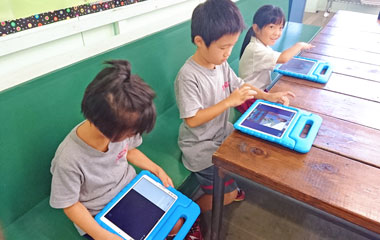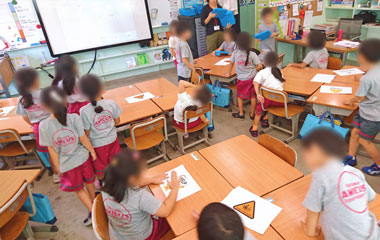One of the first units in life skills for grade 1 is Plant observation and growing a Morning Glory. In this unit students learn the different steps when growing a plant and what materials they need to do so. Students also realize that although they are children they can create life and contribute to a green healthy environment.
Before we started using LoiLoNote, students planted a Morning Glory seed in their pots and observed their plants from seed to seed pod. In order to keep track of the changes, students kept an observation journal booklet. Students learnt about the material they need to use to grow a plant (pot, seed, trellis, soil, seeds and PET bottle), the different plant growth stages and the needs of the plants. While students were writing their observation journal on a worksheet, I decided it would be interesting for students to make a presentation about everything they had already learnt to grow a Morning Glory. It would actually help them remember what they have learnt and put order in their thoughts.

The Benefits of Using LoiLoNote School in this Unit
- Students take responsibility of their own project as they have a deadline to meet and certain steps to follow.
- Students can work in teams and help each other. E.g.: recording their voices
- By making a presentation students learn how to organize themselves (ideas, images) and how to follow different steps.
- Students become creators of their own media artwork instead of passive viewers.
- Shy students, who refuse speaking in English, feel more confident recording their voice as they have several chances to re-record and nobody is listening to them.
Objectives of the Unit
- Learning the Life Cycle of a plant: seed, sprout, seedling, flower and seed pod.
- Identifying the different material needed for growing a plant.
- Identifying the needs of a plant: water, air, space, light, soil.
- Designing a plant observation log in the shape of a presentation with voiceover.
- Learning how to use LoiLoNote: creating notes, taking pictures, saving pictures in folders, submitting work.
- Practising they typing skills and English language skills.
- Self-reflection: students will improve their presentations by means of comparison and classroom rubrics.
Six Scenes from the Unit
1. Pre-activity
Before starting their “How to Grow a Morning Glory” presentation, students first learnt how to use LoiLoNote: how to take pictures, save them in folders, create notes, how to search for material in 1B library, record their voice and save all their work in their own folder. We spent 2 periods learning how to use LoiLoNote.
2. Creating the presentation: taking and saving pictures, creating slides
Once students knew how to use LoiLoNote, they started working on their presentations. This presentation consists of 2 books + final opinion: “1. What materials do you need?”, “2. See my plant grow” and “3. Opinion and what I want to plant next”.
First, students took pictures of material used for growing their plants and also took pictures of their plants at different stages of growth (seed, sprout, seedling, plant, seedpod). After that, students started creating slides and writing and drawing on them.
3. Recording
Students wrote on a worksheet what they wanted to explain in their presentation. They had to practise reading before proceeding to the actual recording. Those students who finished first recording their voices, helped the slower students with reading and recording. Students had a deadline every day and had to submit their work for the teacher to check how far they got and see what they were struggling with.
4. Rubric and peer/teacher’s feedback
Once all the presentations were more or less finished, students had to submit their final presentations to me. We showed 2 different presentations in class, and students had to assess these 2 presentations by means of a rubric: voice, content and creativity. Students had to give meaningful feedback to their classmates.
5. Fine tuning presentations and final submission to teacher
After comparing some presentations and providing feedback, students were given more time to improve their presentations.






